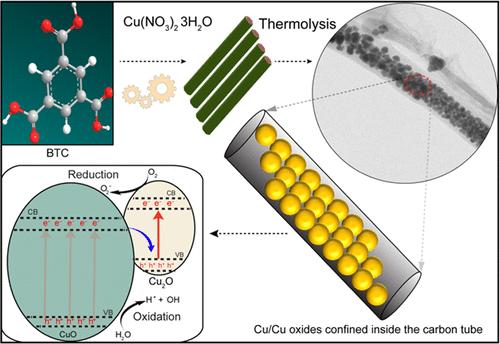mof衍生的铜/氧化铜纳米颗粒在碳管内的原位约束:一种具有优越可见光驱动光催化效率的易于形貌控制的合成策略
IF 3.9
3区 工程技术
Q2 ENGINEERING, CHEMICAL
引用次数: 0
摘要
研究人员开发了一种简单的原位工艺,将CuxO/Cu (x = 1,2)纳米颗粒(CUO)限制在碳管(CT)内,通过形貌控制合成产生复合材料(CUO- ict),该合成具有显着的光催化效率。通过单一前驱体,CUO可以被捕获在CT内,从而克服了限制CUO和金属有机骨架(MOF)基材料衍生的碳复合材料光催化效果的两个主要障碍:CUO的聚集/团聚和带结构的不正确排列。性能最好的CUO-iCT复合材料在可见光下80 min的阳离子和阴离子染料分解率分别为98%和92%,是标准商用光催化剂(TiO2)的两倍。光催化反应的速率常数是光解反应的17倍,具有良好的可回收性。CUO- ict的显著效率是由于分散良好的CUO在CT中的协同作用,导致带隙减小、光吸收红移、活性位点丰富、表面体积比高、e—h+分离时间延长以及约束效应。本文章由计算机程序翻译,如有差异,请以英文原文为准。

MOF-Derived In Situ Confinement of Copper/Copper Oxide Nanoparticles Inside a Carbon Tube: A Facile Morphologically Controlled Synthesis Strategy for Superior Visible-Light-Driven Photocatalytic Efficiency
A facile in situ process was developed to confine CuxO/Cu (x = 1,2) nanoparticles (CUO) inside a carbon tube (CT) to create composites (CUO-iCT) via a morphology-controlled synthesis that exhibits remarkable photocatalytic efficiency. Through a single precursor, CUO could be trapped inside the CT, thereby overcoming two major barriers that have limited photocatalytic efficacy of CUO and carbon composite derived from metal–organic framework (MOF)-based material: aggregation/agglomeration of CUO and improper alignment of the band structure. The best-performing CUO-iCT composite demonstrated 98 and 92% decompositions of cationic and anionic dyes under visible light for 80 min, twice that of the standard commercial photocatalyst (TiO2). Moreover, the photocatalytic reaction showed a rate constant 17 times greater than that of the photolysis reaction with excellent recyclability. The remarkable efficiency of CUO-iCT is due to the synergetic effect of well-dispersed CUO in CT, leading to a reduced band gap, red shift in light absorption, rich active sites, high surface-to-volume ratio, prolonged e-–h+ separation, and confinement effect.
求助全文
通过发布文献求助,成功后即可免费获取论文全文。
去求助
来源期刊

Industrial & Engineering Chemistry Research
工程技术-工程:化工
CiteScore
7.40
自引率
7.10%
发文量
1467
审稿时长
2.8 months
期刊介绍:
ndustrial & Engineering Chemistry, with variations in title and format, has been published since 1909 by the American Chemical Society. Industrial & Engineering Chemistry Research is a weekly publication that reports industrial and academic research in the broad fields of applied chemistry and chemical engineering with special focus on fundamentals, processes, and products.
 求助内容:
求助内容: 应助结果提醒方式:
应助结果提醒方式:


